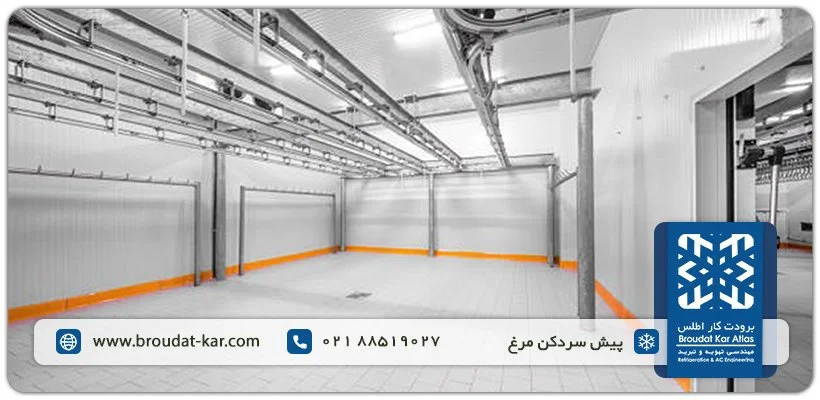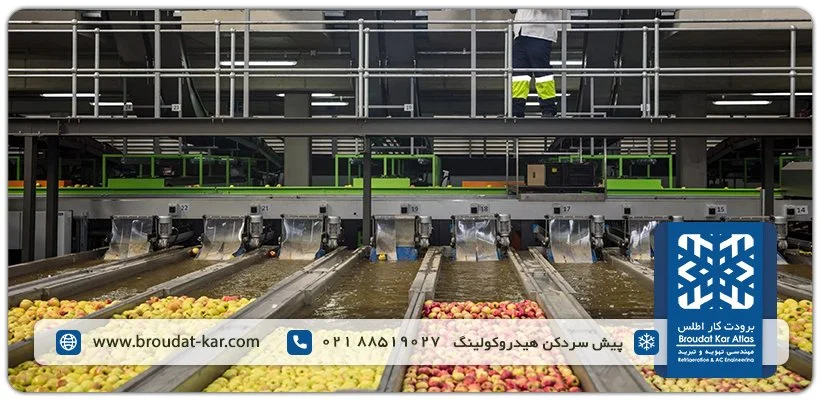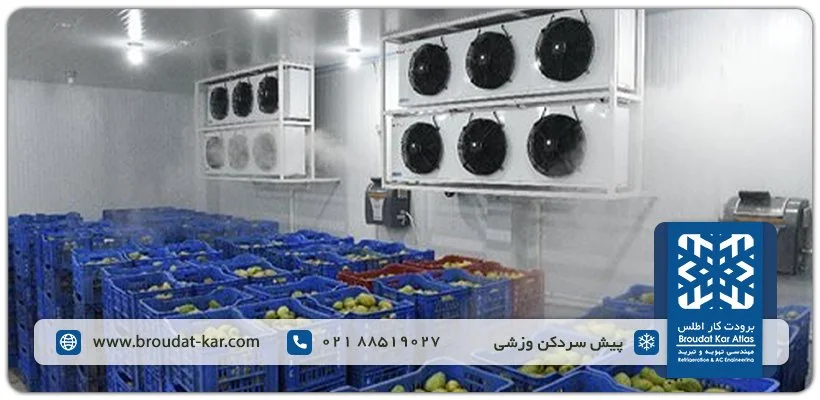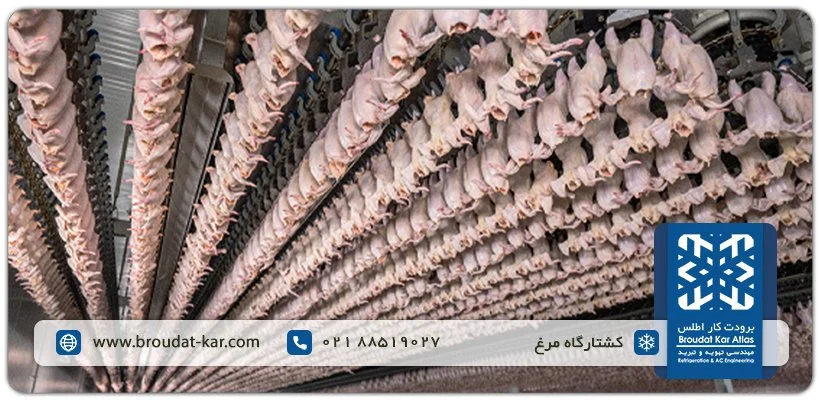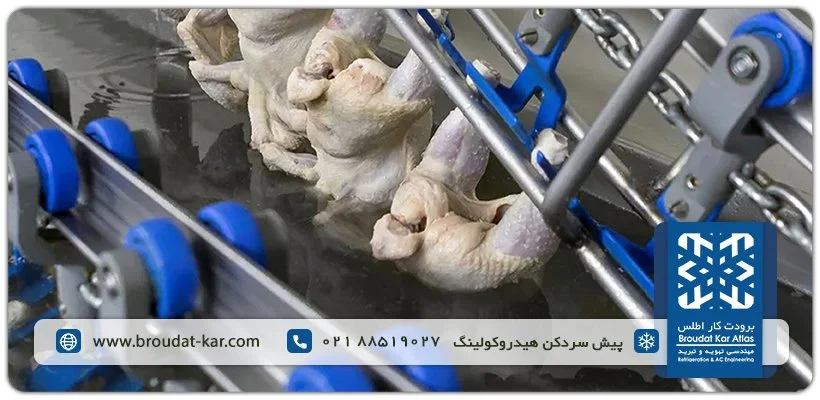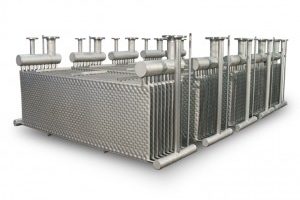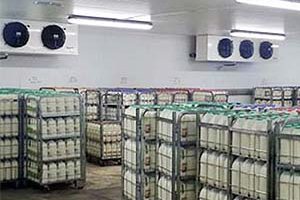What is Pre-Cooling or Pre-cooler?
Pre-cooling, also referred to as pre-cooler, represents a pivotal technique within industries involved in the preservation and refrigeration of fresh, perishable food items. This method involves subjecting products to a controlled environment for a brief duration preceding the primary cooling phase, such as storage in a cold room or freezing, with the aim of reducing their temperature proximity to the freezing point. This meticulous process, known as pre-cooling, is instrumental in enhancing the longevity and quality of perishable goods by mitigating the potential for microbial proliferation and enzymatic degradation that hasten spoilage.
The Purpose of Pre-Cooling Room and its Applications
The pre-cooling room serves a pivotal purpose in creating an insulated environment optimized for temperature control, typically maintained around zero degrees Celsius, alongside suitable humidity levels. Its primary function involves preparing products before the ultimate preservation or freezing phase. By pre-cooling items before they enter the primary cooling stage, there’s a notable reduction in the energy required to attain the final desired temperature.
This enhancement in energy efficiency holds significant importance for two key reasons. Firstly, it diminishes the energy consumption during the primary cooling process, subsequently lowering overall energy expenses. Secondly, by extracting initial heat from the products, it significantly preserves their quality, leading to a rapid reduction in enzymatic activity and microorganism growth, thereby ensuring product integrity.
Benefits of Using Pre-Cooling
Beyond its impact on energy efficiency, pre-cooling yields various effects on both products and the cooling process:
- Product Quality Preservation: Rapid temperature reduction through pre-cooling curtails bacterial, fungal, and enzymatic activities, thereby safeguarding against product spoilage. This process significantly contributes to maintaining the freshness, texture, taste, and nutritional value of the goods.
- Cost Efficiency: Effective use of refrigeration systems, exemplified by pre-cooling, enhances system performance, decreasing overall energy consumption and associated production and maintenance expenses. Furthermore, by mitigating product waste due to inadequate storage, pre-cooling substantially contributes to cost reduction.
- Process Streamlining: Pre-cooling ensures uniform cooling across products before their placement in a cold room. This minimizes both the time and energy required to lower product temperatures within the cold room, thereby optimizing energy balance.
In essence, pre-cooling assumes a pivotal role in the processing and preservation of food products. It not only optimizes cooling processes but also minimizes waste, preserves product quality, and elevates energy efficiency.
Pre-cooling is a refrigeration facility used to reduce the initial temperature of goods resulting from field operations before the freezing process or storage in the cold storage. Pre-coolers have a significant impact on preserving the quality of products in various industries.
Types of Pre-Cooling
Pre-coolers find extensive application across diverse industries, including slaughterhouses, agriculture, fisheries, dairy, and the broader food industry. These systems employ varied methods tailored to specific product types. Here are some common pre-cooling methods:
- Air-circulating Pre-coolers or Air-cooling Rooms: Utilizing high-speed, high-volume air circulation fans, these systems generate robust airflow to cool products. Placing items within the air-cooling room, fans swiftly circulate air over the products, effectively lowering their temperature. This method, prevalent worldwide, is employed for chilling slaughtered livestock, poultry in slaughterhouses, and freshly harvested fruits and vegetables. Air-cooling rooms typically handle capacities ranging from 1 to over 20 tons per shift.
- Water or Hydrocooling: Immersing products in cold water or utilizing heat exchange with water via a heat exchanger aids in temperature reduction. Cold water, often facilitated by shell and tube heat exchangers or ice banks in a refrigeration cycle with compressors and condensers, is used. This rapid method is employed for quickly cooling chicken carcasses and indirectly chilling milk after milking on farms. Water boasts a higher heat transfer coefficient (500 to 10,000 W/m²K) compared to circulating air (10 to 100 W/m²K).
- Icing: Employing flake ice or slurry ice, products directly interact with the ice, rapidly reducing their temperature. This technique utilizes the latent heat of ice melting (80 cal/gr), significantly higher than its specific heat (0.5 cal/gr), to generate cooling. Primarily used for cooling fish and aquatic products post-capture and vegetables during harvesting.
These methods illustrate a subset of pre-cooling techniques, with additional methods existing albeit less prevalent on an industrial scale. Each method possesses distinct advantages and limitations contingent upon product type, production capacity, cooling requisites, and environmental factors. The selection of an optimal pre-cooling method heavily relies on factors such as air or water flow rates, temperature, relative humidity, product geometry, thermal properties, packaging, and arrangement.
Components of the Precooler Room
- Pre-cooling Chamber: The precooling chamber, insulated using polyurethane sandwich panels featuring a density of 40 kg/m³ and a 10-centimeter thickness, utilizes double-sided colored Aluzinc sheets with a 0.5-millimeter thickness. The construction of the chamber doesn’t necessitate traditional building materials apart from the requirement for concrete flooring. The chamber’s door, designed akin to cold storage doors, comprises injected polyurethane with double-sided colored sheets, equipped with appropriate hardware and a locking mechanism.
- Pre-cooler Evaporator: This vital component responsible for refrigerant evaporation employs two main elements: the coil and the fan. The evaporator coil, crafted from copper pipes with aluminum fins for compatibility with various refrigerants (such as R22, R134a, R404a, etc.), can also be fabricated from steel, stainless steel, or aluminum pipes for ammonia refrigerants. The evaporator employs axial-type fans capable of swiftly moving a substantial volume of air at high velocities, ensuring optimal efficiency.
- Condensing Unit or Motor Room: The pre-cooler necessitates a refrigeration cycle, achievable through either a condensing unit (suitable for smaller setups and lower capacities) or a central motor room. Diverse refrigeration compressors, encompassing piston and screw configurations in both hermetic and open designs, integrate into the refrigeration cycle alongside evaporative, air-cooled, or water-cooled condensers. Employing valves, controllers, and an electrical panel, this system guarantees stable and highly efficient cooling for precooling rooms.
Humidity in the Precooler Room
Maintaining an optimal humidity level within the precooling room stands as a pivotal factor in upholding product quality. The ideal relative humidity (RH) typically hovers around 95%, necessitating tight control with minimal fluctuations. Excessive humidity may induce condensation on products, potentially resulting in frost damage characterized by the formation of substantial ice crystals, ultimately harming the cellular structure of the product.
Furthermore, a drop in relative humidity within the precooling room below the moisture content inherent in the product can initiate moisture migration from the product to the surrounding air. This imbalance could manifest as surface wrinkling on the products, not only causing weight loss but also compromising their overall quality. The loss of moisture from the product has a direct impact on its integrity, influencing its texture and appearance.
Factors influencing the selection, purchase and construction of Precooling Systems
When strategizing the establishment of a precooling process for products, several critical considerations come into play. We’ll delve into the pivotal factors influencing the selection of a precooling system and its effective capacity:
- Product Type: The type of product stands as the linchpin in precooling system selection. Each product possesses unique characteristics in cellular density, sugar, and fat content, directly impacting its heat capacity. Tailoring the device to match these specific cooling requirements is paramount.
- Packaging Design: The packaging should facilitate ample air circulation, ensuring sufficient surface areas like vents or holes. These provisions enable unrestricted movement of cold air over the product. Insufficient ventilation can significantly elevate the cooling load.
- Volume-to-Surface Ratio: Products with a lower volume-to-surface ratio cool down faster. For instance, apples exhibit quicker cooling compared to watermelons due to this ratio difference.
- Water or Ice Application: Sensitivity to water or ice application as a precooling method, particularly for items like green beans or tomatoes, should be taken into account.
In summary, prior to investing in a precooling system, it’s advisable to engage with our experts. This allows us to recommend the most suitable precooling method tailored to your specific product needs, ensuring optimal cooling capacity. Get in touch with us for tailored precooling solutions crafted by our specialists.
The pre-cooler is vital for maintaining the freshness and quality of produce. It regulates respiratory activity of fruits, preserves weight and quality, and prevents damage, softening, wilting, and water loss. Moreover, it facilitates the use of smaller equipment for cold storage by controlling the temperature of the products before they enter the cold room.
Conditions and Temperatures for Precooling Various Products
Considering the wide array of products and their unique cooling requisites, conducting a thorough assessment of temperature and capacity for each project is recommended. However, here are some standard product temperature specifications offered as a reference. It’s important to note that these temperature values for the precooler room are approximations and can vary based on the specific demands of individual projects in real-world conditions.
Pre-cooling temperature table of product
| Row | Product | Pre-cooling temperature product (°c) |
| 1 | Fruits | 1-7 |
| 2 | Vegetables | 0-5 |
| 3 | Cut Flowers | 0-2 |
| 4 | Dairy | 2-5 |
| 5 | Bread and flour products | 0-4 |
| 6 | Date | 2-8 |
| 7 | Meat | 0-4 |
Technical specifications of the precooling system
The efficacy of precooling heavily relies on the technical specifications of the refrigeration system. Two primary technical characteristics are pivotal in precooling:
- Cooling Capacity: The refrigeration system’s ability to cool plays a fundamental role in precooling design. This specification determines the sensible heat removal capacity within a specified timeframe. Adequate cooling capacity is vital to manage the heat generated by the products, ensuring efficient and swift cooling.
- Air Circulation: Ensuring appropriate air circulation aligned with the precooling room’s capacity and cooling load is imperative for uniform and rapid product cooling. The refrigeration system must incorporate fans to facilitate the even distribution of cold air throughout the space.Top of Form
Precooling Methods in Slaughterhouses
Precooling stands as a pivotal phase in the slaughterhouse industry, playing a crucial role in preserving meat quality and extending its shelf life by swiftly extracting field heat from the slaughtered carcasses. The primary objective is to halt meat spoilage acceleration caused by heat. Within the slaughterhouse industry, diverse precooling methods are employed. The most prevalent involves utilizing a chilling room or precooling chamber with forced air circulation, rapidly lowering the carcass temperature by directing cold air onto it. Alternatively, smaller carcasses, like poultry, can undergo hydrocooling by immersion in cold water. However, due to the heightened risk of cross-contamination and contaminant spread among carcasses, this method is less favored today. Notably, although this method achieves faster cooling rates, it results in a 5 to 7 percent weight increase due to water absorption.
The selection of a precooling method in a slaughterhouse depends on various factors such as meat type, carcass size, and available resources. For instance, larger carcasses benefit from chilling room precooling, while water immersion is better suited for smaller carcasses despite its substantial water requirement. Commencing the precooling process promptly after slaughter is crucial to prevent carcass temperature rise. Prolonged exposure to ambient temperature heightens the risk of spoilage.
Furthermore, factors like size, shape, and packaging significantly impact precooling effectiveness. Moisture levels also wield considerable influence on maintaining product quality during precooling. Deliberating on these aspects facilitates the optimal selection of a precooling method, ensuring the preservation of meat quality and shelf life.
Precooling System Price
Determining the cost of a precooling device at the outset demands precise details encompassing the product type, volume, input and output temperatures, packaging specifics, and cooling duration for each item. Only with this comprehensive information can the precooling device be custom-designed, its capacity evaluated, and an accurate price estimate provided.
It’s crucial to emphasize that attempting to estimate the price of a precooling device solely based on its dimensions leads to highly inaccurate and fundamentally flawed estimations. Industrial precoolers are meticulously designed and constructed according to precise product specifications and volumes, making it impractical to approximate the cost of a precooling room. To acquire a tailored precooling solution, reaching out to our experts with the aforementioned details is essential. They will promptly offer the most suitable solution tailored to your specific needs and requirements.
Atlas Refrigeration Services for Precooling
Atlas Refrigeration Services is poised to deliver comprehensive services encompassing the design, construction, supply, installation, and after-sales support for precooling products. Drawing upon cutting-edge technical expertise and modern equipment, we specialize in tailoring precooling solutions to suit your business requirements.
Precooling Design:
- Our skilled engineers leverage their expertise to craft efficient and fitting precooling solutions.
- We analyze customer needs, product specifications, and environmental factors to devise optimal precooling system designs.
- Employing advanced technologies and industry best practices ensures maximal efficiency in precooling performance.
Construction and supply of precooling systems:
- We manufacture and supply high-quality precooling equipment and components sourced from reputable brands.
- Our offerings include diverse precooling systems, ranging from air circulation precoolers to hydraulic precoolers utilizing cold water and iced precooling systems.
- Tailored solutions cater to cooling capacity, product type, and specific temperature requisites.
Installation and commissioning of precooling systems:
- Our specialized installation services prioritize precision, efficiency, and safety.
- We oversee all aspects of the installation process, from building to mechanical and electrical equipment setup, piping, cable laying, and integration of control systems.
- Collaborating seamlessly with businesses, we ensure the smooth integration of precooling systems into existing or new facilities.
After-sales precooling services:
- Our after-sales support covers preventive maintenance, routine inspections, swift repairs, and technical assistance, aiming to enhance the longevity and reliability of your refrigeration systems.
- We provide comprehensive after-sales aid to optimize precooling system performance and durability.
- Regular inspections, troubleshooting, and remote monitoring are employed for efficient issue resolution and proactive maintenance.
- Technical support and training for your personnel ensure proficient operation and maintenance of precooling systems.
Atlas Refrigeration Services offers end-to-end engineering solutions for precooling, encompassing system design, equipment supply, professional installation, and continuous after-sales assistance. This comprehensive approach ensures efficient, reliable precooling systems tailored to your needs, maximizing product quality and system longevity.
Conclusion on Precooling
In summary, precooling emerges as a powerful method for both cooling and preserving food items effectively. This article delved into the broad spectrum of precooling, exploring its applications, advantages, diverse methods, factors shaping precooling selection, product-specific precooling temperatures, general technical specifications of precoolers, and the array of services offered by Atlas Refrigeration in the realm of precooling.
For further details or to obtain a customized estimate for a precooling room, don’t hesitate to reach out to us. Our team of experts stands ready to swiftly craft and propose a tailored precooling solution aligned with your business requirements. Contact us today for comprehensive insights and personalized precooling solutions.
Call us for free consultation on refrigeration equipment
You can submit your coldroom proforma inquiry by filling out this form
Related posts
Pre-Cooler
What is Industrial Cold store? An industrial cold store is a large-scale facility designed and constructed to preserve and
Individual Quick Freezing (IQF) IQF or Individual Quick Freezing is commonly used for freezing fruits, berries, vegetables, French fries, shrimp,
